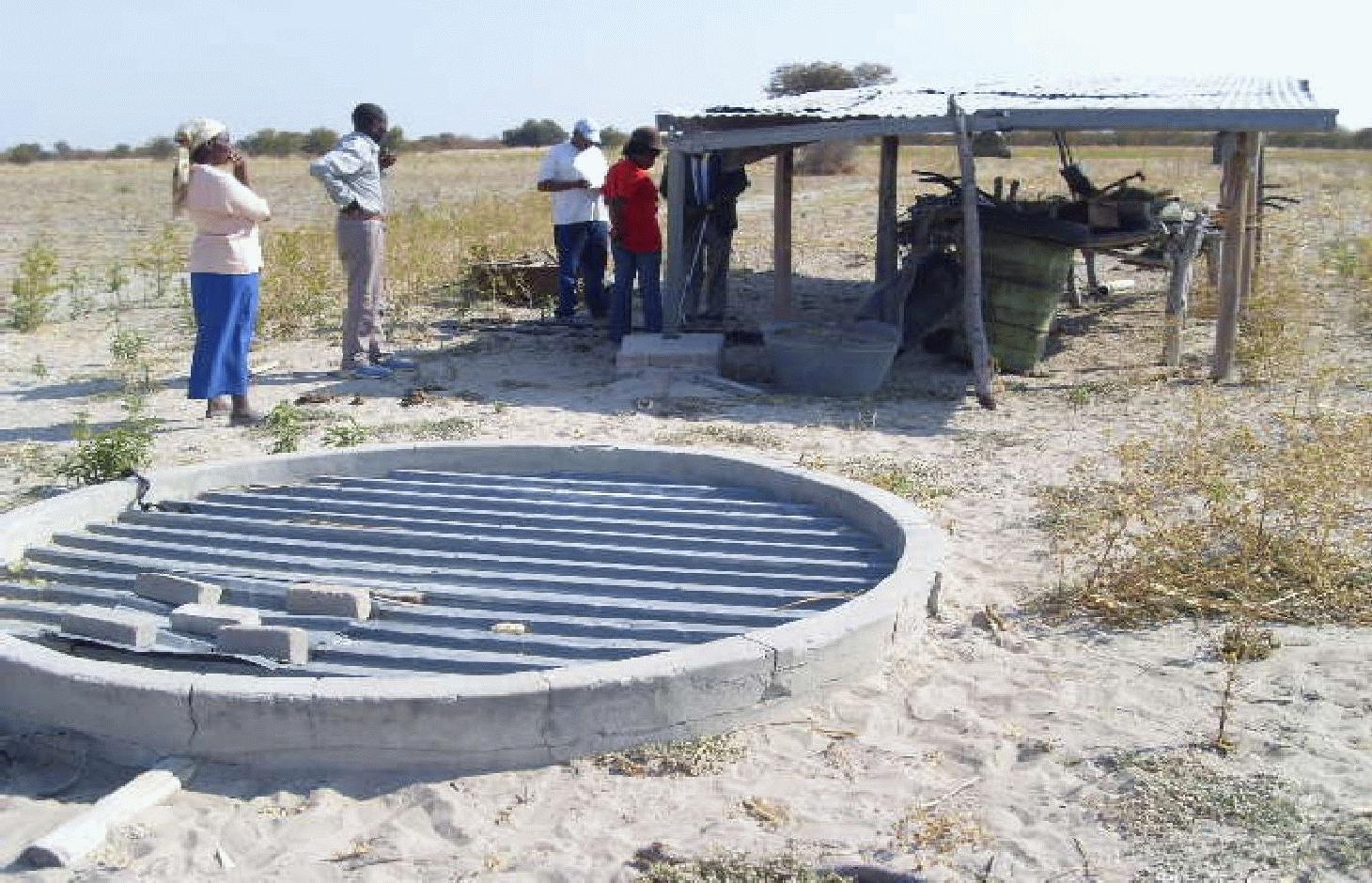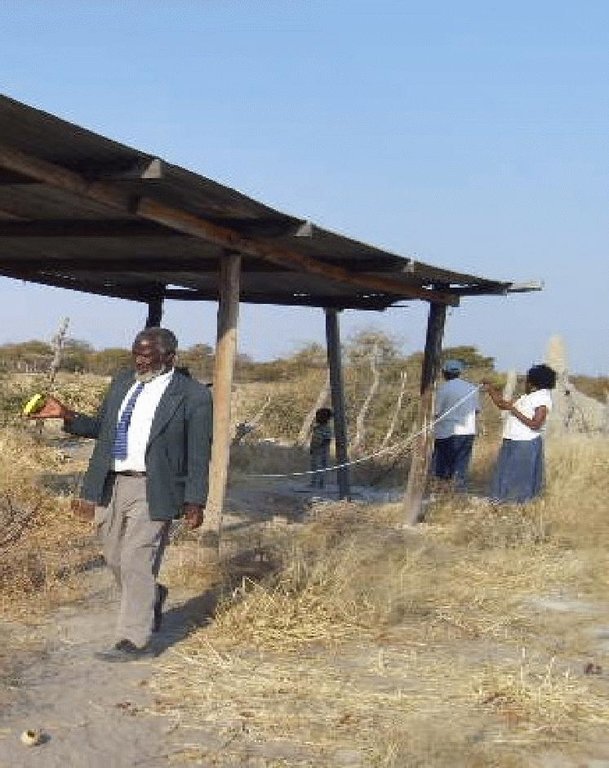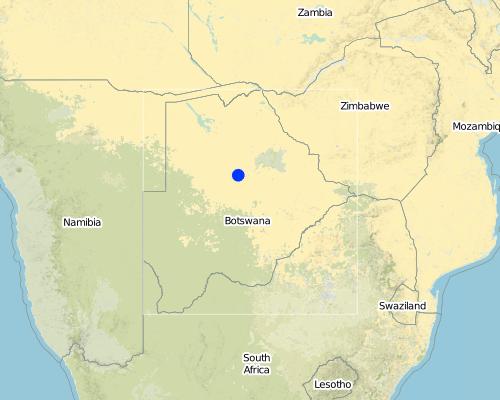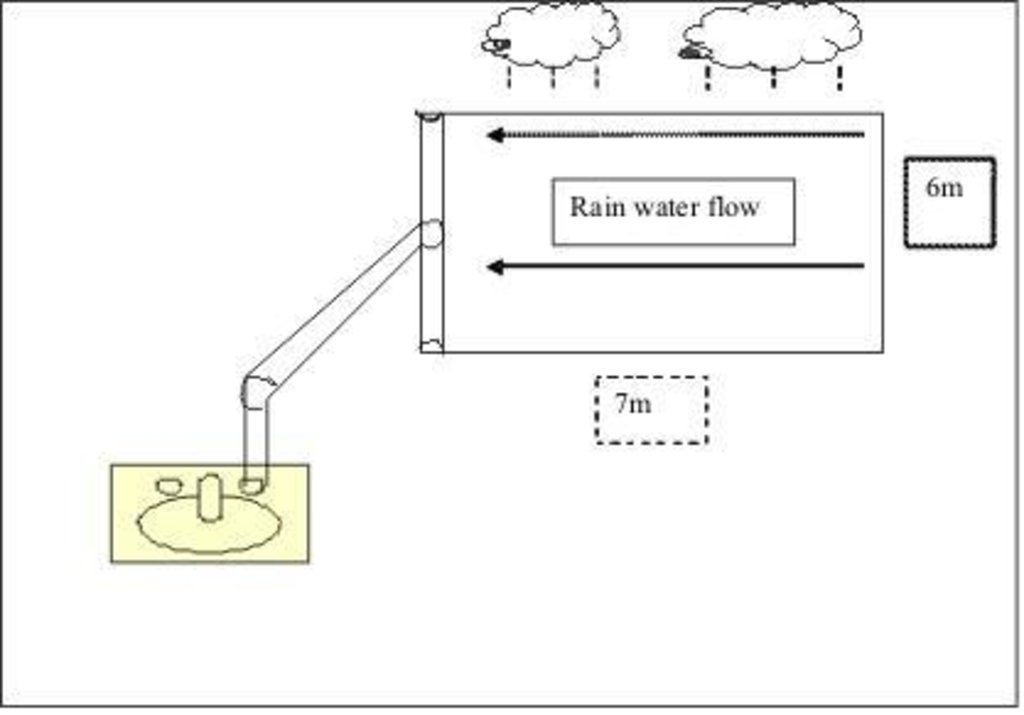Roof rainwater harvesting system [博茨瓦纳]
- 创建:
- 更新:
- 编制者: Julius Atlhopheng
- 编辑者: –
- 审查者: Deborah Niggli
Lekidi
technologies_1417 - 博茨瓦纳
查看章节
全部展开 全部收起1. 一般信息
1.2 参与该技术评估和文件编制的资源人员和机构的联系方式
有助于对技术进行记录/评估的项目名称(如相关)
DESIRE (EU-DES!RE)有助于对技术进行记录/评估的项目名称(如相关)
Book project: Water Harvesting – Guidelines to Good Practice (Water Harvesting)有助于对技术进行记录/评估的机构名称(如相关)
University of Botswana (University of Botswana) - 博茨瓦纳1.3 关于使用通过WOCAT记录的数据的条件
(现场)数据是什么时候汇编的?:
03/06/2011
编制者和关键资源人员接受有关使用通过WOCAT记录数据的条件。:
是
1.4 所述技术的可持续性声明
这里所描述的技术在土地退化方面是否存在问题,导致无法被认为是一种可持续的土地管理技术?:
否
2. SLM技术的说明
2.1 技术简介
技术定义:
Roof rainwater catchment system using galvanised iron roof material, feeding underground water tank.
2.2 技术的详细说明
说明:
A roof of galvanised iron (corrugated iron) with the dimensions 7 x 6m is constructed on a support of gum poles (see photos). The roof catches the rain. The rain water flows over the roof into pipes at the rear end of the roof (sloping side) into an underground conical water tank. The tank is made of bricks and mortar. The underground tank serves two key roles: i) it stores water for use during the dry spells or times of no rain; and ii) the tank keeps the water cool in this hot environment. The technology is most preferred for so-called ‘lands’ areas, to provide household drinking water. On average, these lands are distant from water sources (e.g. 2-15 km). Other benefits of storing rainwater include less pressure on natural water ponds, but this would be a secondary concern
Water is critical for human consumption and needed around the home. The cool water is effective in quenching the thirst; it reduces labour time to collect water thus freeing time to concentrate on other farm activities. The water is mainly for household drinking and household chores like washing. Some is used as drinking water for chickens and for the animals used for draught power (e.g. donkeys during ploughing). The units are for use by individual farmers and thus restricted to individual households. The owner or the farmer has exclusive rights to the use of the water. Some farmers indicated that, in times of no rain, or before the first rains, they collect water from the village in drums, and pour it into this underground water tank, thus using it as a reservoir. They especially like the persistent coolness of water stored in the underground tank.
The technology is for rainwater collection in four villages. Rainwater that flows over the roof is collected, for example, on galvanised iron roofs. The water then runs through gutters and a pipe to the underground water tank. To build the underground tank, the ground is excavated, to about 2m deep and about 3m wide. Within this hole, a drum-like feature is built with concrete bricks and mortar. After the wall of the tank is complete, it is then lined with mortar from the inside, and the base is also lined to form the completed tank. It is then sealed at over most of the surface leaving an opening with a lid. This opening is large enough for a man to enter for occasional cleaning of the groundwater tank. Thus the system comprises a roof, for collecting rainwater, and an underground tank for storing it.
The environment is semi-arid and seasonal rainfall dominates during the summer months of October to April. People depend on nearby boreholes for water in the lands areas or have to travel to the village (about 2-5km away on average, but can be up to 15km) to fetch water. Most boreholes are either privately owned or communal and water is rationed to about two drums per week or even fortnightly. Most of the borehole water in the area is brackish. Thus roof rainwater (which is fresh) acts as the preferred alternative source of water. The underground tank, once full, is equivalent to 110 drums. Most normal rain events fill the tank, and the water remains in use till the next rainy season, which was found to be the case at all four pilot sites visited. Thus the rainwater catchments systems offer water security in the lands areas; water of very good drinking quality (sweet taste, cooler).
2.3 技术照片
2.5 已应用该技术的、本评估所涵盖的国家/地区/地点
国家:
博茨瓦纳
区域/州/省:
Boteti area, in Central District of Botswana
有关地点的进一步说明:
Central District
Map
×2.6 实施日期
如果不知道确切的年份,请说明大概的日期:
- 10-50年前
2.7 技术介绍
详细说明该技术是如何引入的:
- 通过项目/外部干预
注释(项目类型等):
This is an ALDEP (arable lands development project) which is specifically for arable lands areas, to ascertain water provision and it started in the 1980-1990s, then up to mid 2008.
3. SLM技术的分类
3.1 该技术的主要目的
- 降低灾害风险
3.2 应用该技术的当前土地利用类型

农田
- 一年一作

牧场
粗放式放牧场:
- 半游牧/游牧
- 经营牧场
注释:
Major land use problems (compiler’s opinion): The water harvesting system is critical in a semi-arid environment, where water shortages are common. To augment water supplies, storage is needed especially in arable land areas where there are no coordinated water distributions like standpipes, as is the case in villages. People at the lands eke a living out of the arable fields, and assured water availability enables families to remain longer close to the fields for essential crop management, hence increased yields.
Major land use problems (land users’ perception): Water shortage and poor water quality.
Type of cropping system and major crops comments: Very little in a way of cash crops as the production system is subsistence based.
Type of grazing system comments: Free range grazing
Constraints of settlement / urban: piped water is cheap
3.3 有关土地利用的更多信息
该技术所应用土地的供水:
- 雨养
注释:
Water supply: rainfed, rainfed
每年的生长季节数:
- 1
具体说明:
Longest growing period in days: 197, Longest growing period from month to month: Oct - Mar
牲畜密度(如相关):
1-10 LU /km2
3.4 该技术所属的SLM组
- 集水
3.5 技术传播
注释:
Total area covered by the SLM Technology is 0.01 m2.
This is a roof rainwater catchment system which is about 7m by 6m = 42 m2. The collection tank has a capacity of 10 000 litres.
3.6 包含该技术的可持续土地管理措施

结构措施
- S5:大坝、集水斗、水池
3.7 该技术强调的主要土地退化类型

水质恶化
- Hs:地表水良变化
- Hg:地下水/含水层水位的变化
注释:
Main causes of degradation: droughts (Reduced water/moisture due to droughts), land tenure (livelihoods depending on fragile ecosystem)
Secondary causes of degradation: overgrazing (high stocking rates in dry areas), population pressure, poverty / wealth (limited access to water and saline water)
3.8 防止、减少或恢复土地退化
具体数量名该技术与土地退化有关的目标:
- 减少土地退化
4. 技术规范、实施活动、投入和成本
4.1 该技术的技术图纸
4.2 技术规范/技术图纸说明
The top lid of the underground tank:
Rain water falls onto the corrugated roof surface, which usually measures 7 x 6m. This water flows down into the gutters, then down through the pipe into an underground water storage tank (built from concrete blocks which are lined with a coating of mortar, or mortar is applied to wire mesh. Most storage tanks, when full, have a capacity of about 110 drums (a drum holds 200 litres). Without this system, a farmer usually only has about 2 drums per week.
Technical knowledge required for field staff / advisors: moderate (Easy strycture or system to explain)
Technical knowledge required for land users: low (Needs professional builder to construct, but easy to run)
Main technical functions: water harvesting / increase water supply
Secondary technical functions: is used as open storage for farm equipment, offers shade against the heat, as well as temporary shelter
Structural measure: Roof rainwater system (roof)
Width of ditches/pits/dams (m): 6
Length of ditches/pits/dams (m): 7
Structural measure: Tank specifications (conical)
Depth of ditches/pits/dams (m): 2.7
Width of ditches/pits/dams (m): 1.75
Length of ditches/pits/dams (m): 3.5
Construction material (earth): To mix with cement
Construction material (wood): gum poles, rafters for supporting iron roof
Construction material (concrete): To build tank foundation
Construction material (other): iron
Lateral gradient along the structure: 5%
Specification of dams/ pans/ ponds: Capacity 10m3
Catchment area: 42m2
Beneficial area: 5m2
4.3 有关投入和成本计算的一般信息
其它/国家货币(具体说明):
Pula
注明美元与当地货币的汇率(如相关):1美元=:
8.0
注明雇用劳工的每日平均工资成本:
5.00
4.4 技术建立活动
| 活动 | 措施类型 | 时间 | |
|---|---|---|---|
| 1. | Digging pit | 结构性的 | |
| 2. | Transporting sand, cement and concrete blocks | 结构性的 | |
| 3. | Construction | 结构性的 |
4.5 技术建立所需要的费用和投入
| 对投入进行具体说明 | 单位 | 数量 | 单位成本 | 每项投入的总成本 | 土地使用者承担的成本% | |
|---|---|---|---|---|---|---|
| 劳动力 | labour | ha | 1.0 | 12.5 | 12.5 | 100.0 |
| 劳动力 | labour by gov (8 person days) | ha | 1.0 | 500.0 | 500.0 | |
| 施工材料 | sand, cement, concrete block | ha | 1.0 | 1500.0 | 1500.0 | 100.0 |
| 技术建立所需总成本 | 2012.5 | |||||
注释:
Duration of establishment phase: 1 month(s)
4.6 维护/经常性活动
| 活动 | 措施类型 | 时间/频率 | |
|---|---|---|---|
| 1. | Cleaning roof | 结构性的 | once a year, before onset of rains |
| 2. | Cleaning storage tank | 结构性的 | once a year, before onset of rains |
4.7 维护/经常性活动所需要的费用和投入(每年)
| 对投入进行具体说明 | 单位 | 数量 | 单位成本 | 每项投入的总成本 | 土地使用者承担的成本% | |
|---|---|---|---|---|---|---|
| 劳动力 | labour | ha | 1.0 | 12.5 | 12.5 | 100.0 |
| 技术维护所需总成本 | 12.5 | |||||
注释:
Machinery/ tools: Stock bricks, corrugated iron sheets, meshwire, gutters, wire nails. No machinery, just broom and bucket to collect sediment and dispose of it.
Prices of construction material for the roof rainwater system, fitted with the underground water storage system. All prices and exchange rates were calculated for 29 September 2008. The government subsidy was such that, men pay 30% of all costs, while women pay 20%. The 20-30% could be paid through labour (i.e. digging the pit, transporting sand and cement and serving as a labour hand during construction. Thus if the farmer offers labour, then he does not pay anything. The costs are calculated with labour input and its price or the local wage.
4.8 影响成本的最重要因素
描述影响成本的最决定性因素:
Cost of building materials, specifically iron sheets, timber, bricks, concrete and the professional builder from the government.
5. 自然和人文环境
5.1 气候
年降雨量
- < 250毫米
- 251-500毫米
- 501-750毫米
- 751-1,000毫米
- 1,001-1,500毫米
- 1,501-2,000毫米
- 2,001-3,000毫米
- 3,001-4,000毫米
- > 4,000毫米
农业气候带
- 半干旱
Thermal climate class: subtropics. sub-tropical thermal climate (hot summers, cool winters)
5.2 地形
平均坡度:
- 水平(0-2%)
- 缓降(3-5%)
- 平缓(6-10%)
- 滚坡(11-15%)
- 崎岖(16-30%)
- 陡峭(31-60%)
- 非常陡峭(>60%)
地形:
- 高原/平原
- 山脊
- 山坡
- 山地斜坡
- 麓坡
- 谷底
垂直分布带:
- 0-100 m a.s.l.
- 101-500 m a.s.l.
- 501-1,000 m a.s.l.
- 1,001-1,500 m a.s.l.
- 1,501-2,000 m a.s.l.
- 2,001-2,500 m a.s.l.
- 2,501-3,000 m a.s.l.
- 3,001-4,000 m a.s.l.
- > 4,000 m a.s.l.
5.3 土壤
平均土层深度:
- 非常浅(0-20厘米)
- 浅(21-50厘米)
- 中等深度(51-80厘米)
- 深(81-120厘米)
- 非常深(> 120厘米)
土壤质地(表土):
- 粗粒/轻(砂质)
- 细粒/重质(粘土)
表土有机质:
- 中(1-3%)
- 低(<1%)
5.4 水资源可用性和质量
地下水位表:
5-50米
地表水的可用性:
匮乏/没有
水质(未处理):
不良饮用水(需要处理)
5.5 生物多样性
物种多样性:
- 高
5.6 应用该技术的土地使用者的特征
生产系统的市场定位:
- 生计(自给)
非农收入:
- 低于全部收入的10%
相对财富水平:
- 非常贫瘠
- 非常丰富
个人或集体:
- 个人/家庭
机械化水平:
- 畜力牵引
性别:
- 女人
- 男人
说明土地使用者的其他有关特征:
Land users applying the Technology are mainly disadvantaged land users
Population density: < 10 persons/km2
Annual population growth: 2% - 3%
10% of the land users are very rich and own 50% of the land (rich cattle barons).
60% of the land users are average wealthy and own 30% of the land (most inhabitants).
30% of the land users are poor and own 20% of the land (subsistence farmers).
Off-farm income specification: Saves labour time to fetch water. Very limited off-farm income opportunities for everyone, including non-adopters of the technology
5.7 应用该技术的土地使用者拥有或租用的平均土地面积
- < 0.5 公顷
- 0.5-1 公顷
- 1-2 公顷
- 2-5公顷
- 5-15公顷
- 15-50公顷
- 50-100公顷
- 100-500公顷
- 500-1,000公顷
- 1,000-10,000公顷
- > 10,000公顷
这被认为是小规模、中规模还是大规模的(参照当地实际情况)?:
- 小规模的
5.8 土地所有权、土地使用权和水使用权
土地所有权:
- 社区/村庄
- 个人,未命名
土地使用权:
- 自由进入(无组织)
- 个人
用水权:
- 社区(有组织)
- 个人
注释:
Communal grazing and individual land ownership for ploughing. Water availed through communal boreholes in lands and cattle posts, but with individual standpipes in villages. Open access to surface water resources for livestock e.g. pans after rains. Dual grazing rights problem, whereby private ranchers graze in the commons, but the opposite not possible.
5.9 进入服务和基础设施的通道
健康:
- 贫瘠
- 适度的
- 好
教育:
- 贫瘠
- 适度的
- 好
技术援助:
- 贫瘠
- 适度的
- 好
就业(例如非农):
- 贫瘠
- 适度的
- 好
市场:
- 贫瘠
- 适度的
- 好
能源:
- 贫瘠
- 适度的
- 好
道路和交通:
- 贫瘠
- 适度的
- 好
饮用水和卫生设施:
- 贫瘠
- 适度的
- 好
金融服务:
- 贫瘠
- 适度的
- 好
6. 影响和结论性说明
6.1 该技术的现场影响
社会经济效应
生产
作物生产
SLM之前的数量:
0.15 t/ha/y
SLM之后的数量:
0.195 t/ha/y
注释/具体说明:
30% increase due to more time to manage crops better e.g. weeding
畜牧生产
注释/具体说明:
mainly chickens and small stock
生产故障风险
SLM之前的数量:
40%
SLM之后的数量:
10%
注释/具体说明:
more time on farm
水资源可用性和质量
饮用水的可用性
注释/具体说明:
water year round
收入和成本
农业投入费用
SLM之前的数量:
5%
SLM之后的数量:
90%
注释/具体说明:
at construction phase only
收入来源的多样性
SLM之前的数量:
3%
SLM之后的数量:
25%
注释/具体说明:
from horticulture, chickens etc
经济差异
SLM之前的数量:
5%
SLM之后的数量:
90%
注释/具体说明:
poor cannot afford it
工作量
注释/具体说明:
no time lost in collecting water afar
社会文化影响
食品安全/自给自足
SLM之前的数量:
5%
SLM之后的数量:
35%
注释/具体说明:
better yields with more on-farm time
健康状况
SLM之前的数量:
5%
SLM之后的数量:
40%
注释/具体说明:
the water is better than in region
社区机构
SLM之前的数量:
6%
SLM之后的数量:
50%
注释/具体说明:
uplifting of the disadvantaged
SLM/土地退化知识
SLM之前的数量:
4%
SLM之后的数量:
50%
冲突缓解
注释/具体说明:
conflicts exist over boreholes
社会经济弱势群体的情况
注释/具体说明:
improved water provision, not affordable for the poor (unless subsidized)
contribution to human well-being
注释/具体说明:
Many educational tours made on these demonstration sites. Fresh rainwater is good for health compared to borehole (salty) water.
生态影响
水循环/径流
水量
SLM之前的数量:
5%
SLM之后的数量:
80%
注释/具体说明:
water year round
水质
注释/具体说明:
not salty/saline, to clean roof and tank annually (temporarily)
水的回收/收集
SLM之前的数量:
1%
SLM之后的数量:
90%
注释/具体说明:
resource from previous year used
蒸发
SLM之前的数量:
1%
SLM之后的数量:
90%
注释/具体说明:
underground water tank, sealed
减少气候和灾害风险
碳和温室气体的排放
SLM之前的数量:
1%
SLM之后的数量:
90%
注释/具体说明:
clean technology
6.2 该技术的场外影响已经显现
水资源可用性
SLM之前的数量:
2 drums/we
SLM之后的数量:
42drums/we
注释/具体说明:
all this water saved due to technology
6.3 技术对渐变气候以及与气候相关的极端情况/灾害的暴露和敏感性(土地使用者认为的极端情况/灾害)
渐变气候
渐变气候
| 季节 | 气候变化/极端天气的类型 | 该技术是如何应对的? | |
|---|---|---|---|
| 年温度 | 增加 | 好 |
气候有关的极端情况(灾害)
气象灾害
| 该技术是如何应对的? | |
|---|---|
| 局地暴雨 | 好 |
气候灾害
| 该技术是如何应对的? | |
|---|---|
| 干旱 | 不好 |
水文灾害
| 该技术是如何应对的? | |
|---|---|
| 比较和缓的(河道)洪水 | 好 |
其他气候相关的后果
其他气候相关的后果
| 该技术是如何应对的? | |
|---|---|
| 缩短生长期 | 好 |
注释:
The roof area is such that, some limited amounts of rain do fill or add some water into the storage tank
6.4 成本效益分析
技术收益与技术建立成本相比如何(从土地使用者的角度看)?
短期回报:
非常消极
长期回报:
非常积极
技术收益与技术维护成本/经常性成本相比如何(从土地使用者的角度看)?
短期回报:
非常消极
长期回报:
非常积极
注释:
Very costly to set up, if no government aid. It is however, very good for long term water provision.
6.5 技术采用
注释:
1% of land user families have adopted the Technology with external material support
1 land user families have adopted the Technology with external material support
There is one such structure per village in Boteti sub-district - and they are all demonstration schemes. There was no public uptake following demonstration, as government subsidy changed and was later stopped.
It is too costly e.g. building materials, hiring of professional builder and cement to set up in lands areas.
There is no trend towards spontaneous adoption of the Technology
High capital or start-up costs. The area has low income groups who get water from communal boreholes, while rich cattle owners obtain water from their private boreholes, and hence desalination is favoured rather than rainwater systems.
6.7 该技术的优点/长处/机会
| 土地使用者眼中的长处/优势/机会 |
|---|
| Useful as shelter or storage |
| 编制者或其他关键资源人员认为的长处/优势/机会 |
|---|
| Provides cool water in hot summers |
| Provides water in lands areas, where it is most needed |
| Farmers appreciate the good water quality and clean system annually |
| It has low maintenance costs, it is easy to use |
6.8 技术的弱点/缺点/风险及其克服方法
| 土地使用者认为的弱点/缺点/风险 | 如何克服它们? |
|---|---|
| Costly to set up, due to price of building materials | Government subsidies, priviate sector, NGOs |
| Fear that their land would be taken away by the government after financial assistance | Education about subsidies to allay fears |
| 编制者或其他关键资源人员认为的弱点/缺点/风险 | 如何克服它们? |
|---|---|
| Costly to set up | subsidies by government, NGOs, private sector |
| Seen as dependent on rains, thus fails during droughts | research, information dissemination to stakeholders |
| Water quality issues (concerns) | education on keeping storage clean and boiling water for human consumption |
7. 参考和链接
7.1 信息的方法/来源
- 实地考察、实地调查
- 与土地使用者的访谈
7.2 参考可用出版物
标题、作者、年份、ISBN:
Ministry of Agriculture Headquarters, Department of Crop Production, Engineering Division, Water Development Section,
可以从哪里获得?成本如何?
P/Bag 003, Gaborone,
标题、作者、年份、ISBN:
en.wikepedia.org/wiki/rainwater-harvesting
可以从哪里获得?成本如何?
website
标题、作者、年份、ISBN:
www.harvesth2O.com
可以从哪里获得?成本如何?
website
标题、作者、年份、ISBN:
www.rainwaterharvesting.org/index.htm
可以从哪里获得?成本如何?
website
标题、作者、年份、ISBN:
www.rainwaterharvesting.co.uk
可以从哪里获得?成本如何?
website
标题、作者、年份、ISBN:
cgwb.gov.in/Ground Water/roof-top.htm
可以从哪里获得?成本如何?
website
链接和模块
全部展开 全部收起链接
无链接
模块
无模块






